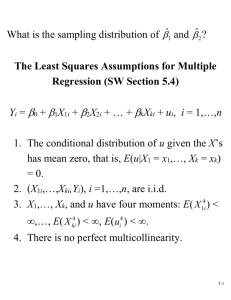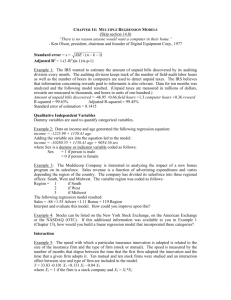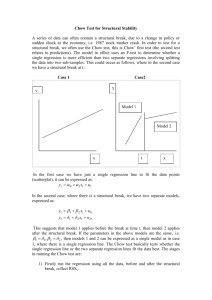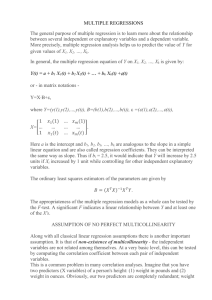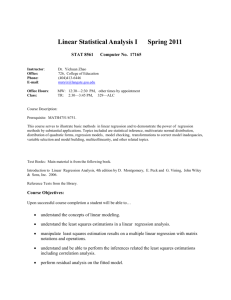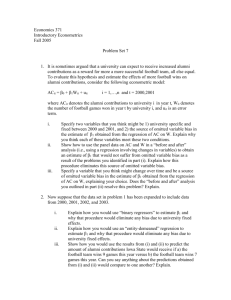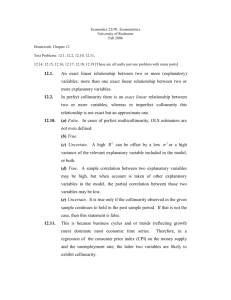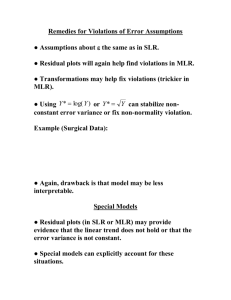EEP/IAS 118 Spring `14Omitted Variable Bias versus
advertisement
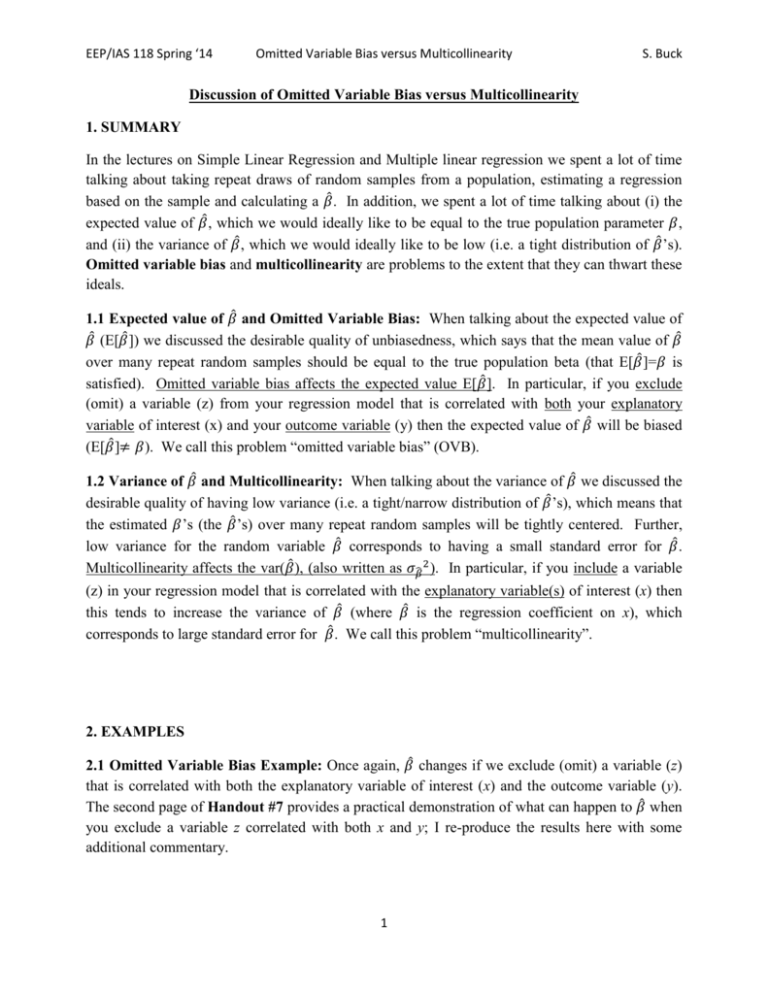
EEP/IAS 118 Spring ‘14 Omitted Variable Bias versus Multicollinearity S. Buck Discussion of Omitted Variable Bias versus Multicollinearity 1. SUMMARY In the lectures on Simple Linear Regression and Multiple linear regression we spent a lot of time talking about taking repeat draws of random samples from a population, estimating a regression based on the sample and calculating a 𝛽̂ . In addition, we spent a lot of time talking about (i) the expected value of 𝛽̂ , which we would ideally like to be equal to the true population parameter 𝛽, and (ii) the variance of 𝛽̂ , which we would ideally like to be low (i.e. a tight distribution of 𝛽̂ ’s). Omitted variable bias and multicollinearity are problems to the extent that they can thwart these ideals. 1.1 Expected value of 𝛽̂ and Omitted Variable Bias: When talking about the expected value of 𝛽̂ (E[𝛽̂ ]) we discussed the desirable quality of unbiasedness, which says that the mean value of 𝛽̂ over many repeat random samples should be equal to the true population beta (that E[𝛽̂ ]=𝛽 is satisfied). Omitted variable bias affects the expected value E[𝛽̂ ]. In particular, if you exclude (omit) a variable (z) from your regression model that is correlated with both your explanatory variable of interest (x) and your outcome variable (y) then the expected value of 𝛽̂ will be biased (E[𝛽̂ ]≠ 𝛽). We call this problem “omitted variable bias” (OVB). 1.2 Variance of 𝛽̂ and Multicollinearity: When talking about the variance of 𝛽̂ we discussed the desirable quality of having low variance (i.e. a tight/narrow distribution of 𝛽̂ ’s), which means that the estimated 𝛽’s (the 𝛽̂ ’s) over many repeat random samples will be tightly centered. Further, low variance for the random variable 𝛽̂ corresponds to having a small standard error for 𝛽̂ . Multicollinearity affects the var(𝛽̂ ), (also written as 𝜎𝛽̂ 2 ). In particular, if you include a variable (z) in your regression model that is correlated with the explanatory variable(s) of interest (x) then this tends to increase the variance of 𝛽̂ (where 𝛽̂ is the regression coefficient on x), which corresponds to large standard error for 𝛽̂ . We call this problem “multicollinearity”. 2. EXAMPLES 2.1 Omitted Variable Bias Example: Once again, 𝛽̂ changes if we exclude (omit) a variable (z) that is correlated with both the explanatory variable of interest (x) and the outcome variable (y). The second page of Handout #7 provides a practical demonstration of what can happen to 𝛽̂ when you exclude a variable z correlated with both x and y; I re-produce the results here with some additional commentary. 1 EEP/IAS 118 Spring ‘14 Omitted Variable Bias versus Multicollinearity S. Buck From Handout #7: Omitting an important variable correlated with the other independent variables: Omitted variable bias = 1.17 + .106 educ (.08) (.005) +.011 exp (.0009) - .26 female (.02) + .012 profocc (.03) R2 = .28 n = 2000 = 2.57 + (.03) +.011 exp (.0009) - .26 female (.02) + .358 profocc (.03) R2 = .16 n = 2000 Additional Commentary on Handout #7: The difference between these regression models is that the second model excludes ‘educ’. As indicated, in the second equation we have excluded (omitted) the variable ‘educ’ which is an important variable in that it determines the outcome (i.e. education is correlated with log(wages)); ‘educ’ is also correlated with other explanatory variables, in particular, the indicator for whether your employment type is a professional occupation (‘profocc’). These correlations are demonstrated in the correlation matrix below. The correlation between ‘educ’ and ‘lwage’ is 0.4097 (positive) and the correlation between ‘educ’ and ‘profocc’ is 0.4276 (positive). As a consequence, in the second equation the regression coefficient on ‘profocc’ is measuring the effect of both having higher education and having a professional occupation; that is, the regression coefficient on ‘profocc’ exhibits a bias relative to the first equation. Consistent with demonstrations from class, the bias present in the regression coefficient on ‘profocc’ in the second equation (0.358) is positive relative to the first equation. Said differently, due to the exclusion of ‘educ’ the regression coefficient on ‘profocc’ in the second equation is positively biased relative to the first equation. . correlate lwage educ exp female profocc nonwhite (obs=2000) | lwage educ exper female profocc nonwhite -------------+-----------------------------------------------------lwage | 1.0000 educ | 0.4097 1.0000 exper | 0.2358 0.0010 1.0000 female | -0.1935 0.0489 0.0210 1.0000 profocc | 0.2181 0.4276 -0.0383 0.1077 1.0000 nonwhite | -0.0379 -0.0051 -0.0200 0.0368 -0.0143 1.0000 2.2 Multicollinearity Example: As we add variables to our regression model that are correlated with the explanatory variable(s) of interest, then the standard errors for the 𝛽̂ ’s on the explanatory variable(s) of interest will increase. The first page of Handout #8 provides a practical demonstration of what happens to the standard errors for your 𝛽̂ ’s when you include a variable that is highly correlated with the explanatory variables already in the model; I re-produce the relevant results from Handout #8 here with some additional commentary. 2 EEP/IAS 118 Spring ‘14 Omitted Variable Bias versus Multicollinearity S. Buck From Handout #8: (1) None . reg lwage educ exper female Source | SS df MS -------------+-----------------------------Model | 182.35726 3 60.7857535 Residual | 490.219607 1996 .245601005 -------------+-----------------------------Total | 672.576867 1999 .336456662 Number of obs F( 3, 1996) Prob > F R-squared Adj R-squared Root MSE = = = = = = 2000 247.50 0.0000 0.2711 0.2700 .49558 -----------------------------------------------------------------------------lwage | Coef. Std. Err. t P>|t| [95% Conf. Interval] -------------+---------------------------------------------------------------educ | .1167441 .0053157 21.96 0.000 .1063191 .127169 exper | .0109089 .000869 12.55 0.000 .0092046 .0126132 female | -.2543189 .0222067 -11.45 0.000 -.2978696 -.2107682 _cons | 1.055792 .0757381 13.94 0.000 .9072576 1.204326 ------------------------------------------------------------------------------ (1) Almost collinear . reg lwage educ exper female age Source | SS df MS -------------+-----------------------------Model | 182.468262 4 45.6170655 Residual | 490.108605 1995 .245668474 -------------+-----------------------------Total | 672.576867 1999 .336456662 Number of obs F( 4, 1995) Prob > F R-squared Adj R-squared Root MSE = = = = = = 2000 185.69 0.0000 0.2713 0.2698 .49565 -----------------------------------------------------------------------------lwage | Coef. Std. Err. t P>|t| [95% Conf. Interval] -------------+---------------------------------------------------------------educ | .1692465 .1115687 1.52 0.129 -.0495568 .3880498 exper | .0633711 .1113346 0.57 0.569 -.1549732 .2817154 female | -.2545469 .0222135 -11.46 0.000 -.298111 -.2109827 age | -.0524796 .1113744 -0.47 0.638 -.270902 .1659428 _cons | 1.370917 .6728026 2.04 0.042 .0514472 2.690386 ------------------------------------------------------------------------------ Commentary on example from Handout #8: The difference between these regression models is that the second model includes the variable ‘age’. In the first set of regression results we see relatively small standard errors for the 𝛽̂ ’s on ‘educ’ and ‘exper’ as indicated by numbers reported in the column under ‘Std. Err.’. In the second set of regression results we see that standard errors for these two 𝛽̂ ’s are considerably larger. Why does this happen? If the variable added to the regression equation (e.g. age) is highly correlated with variables already in the model (e.g. educ and exper), then standard errors for the associated 𝛽̂ will get very large. This is what is meant by multicollinearity. We are concerned about multicollinearity because large standard errors for the 𝛽̂ ’s produce large confidence intervals and makes it likely that you will fail to reject the null hypothesis even if the magnitude of the estimated regression coefficient (𝛽̂ ) is much different than the null hypothesis. Note: The heading “None” on the first set of regression results reflects the 3 EEP/IAS 118 Spring ‘14 Omitted Variable Bias versus Multicollinearity S. Buck fact that the standard errors are small, which suggests that the variables in the model are not close to being collinear (i.e. they are not close to being perfectly correlated). The heading “Almost collinear” for the second set of regression results reflects the fact that the standard errors are very large, which suggest that some of the variables are very highly correlated (i.e. they are almost collinear/perfectly correlated). 3. INTERPRETATION: Question 2 on Quiz #1 The T/F question on Quiz #1 was designed to help illustrate the difference between the problem of omitted variable bias and multicollinearity before exam time. I know the question was a difficult one for many of you so it is a good idea to re-visit the problem. As the discussion above suggests, good ways to distinguish between Omitted Variable Bias and Multicollinearity are: Omitted variable bias affects the E[𝛽̂ ], while multicollinearity affects the var[𝛽̂ ]. Omitted variable bias can occur when you exclude an additional variable (z) from your regression model, while multicollinearity can occur when you include an additional variable. Omitted variable bias is problematic when an excluded (omitted) variable z is correlated with both the explanatory variable of interest and the outcome variable, while multicollinearity can be introduced if an included variable z is correlated with just the explanatory variable of interest (x) regardless of whether the included variable z is correlated with the outcome variable (y). Having summarized these distinguishing characteristics, let’s revisit the question on multicollinearity from Quiz #1 which I re-produce: Multicollinearity in a multiple linear regression model arises when you add covariates (explanatory variables) to the regression model that are highly correlated with the explanatory variable of interest. T/F When adding covariates to your multiple linear regression model that are highly correlated with the explanatory variable of interest, this multicollinearity is a cause for concern because it biases the beta coefficient on the explanatory variable of interest. Justify your answer in a sentence or two (i.e.: if you answer true or false, explain why the answer is true or false). Response: You already have the solution so I won’t reproduce that here. However, I wanted to make explicit the clues that should have signaled to you that something was wrong with the statement. The statement clearly indicates that we are adding variables to our model—this would not introduce omitted variable bias, because that happens when we exclude variables from the model, not include variables. Second, the concept of multicollinearity relates to a high degree of correlation between just explanatory variables and how this affects the variance of the betas, not bias in the regression coefficients (𝛽̂ ’s) themselves. 4
